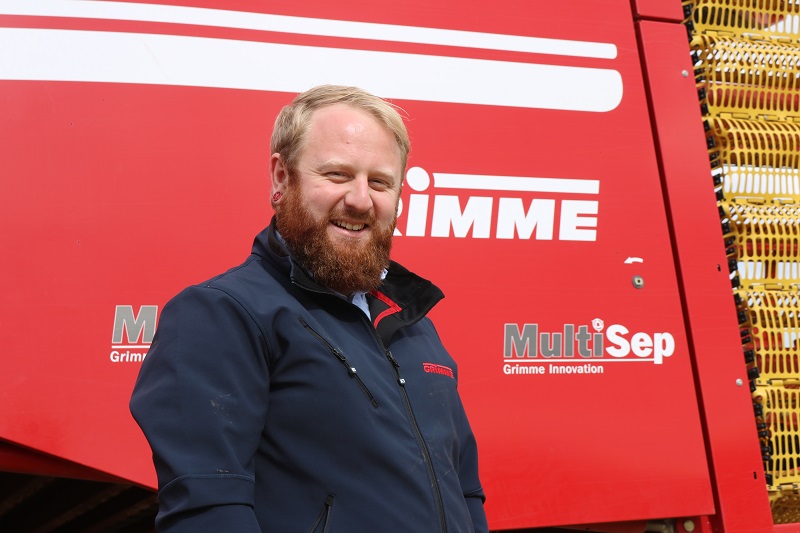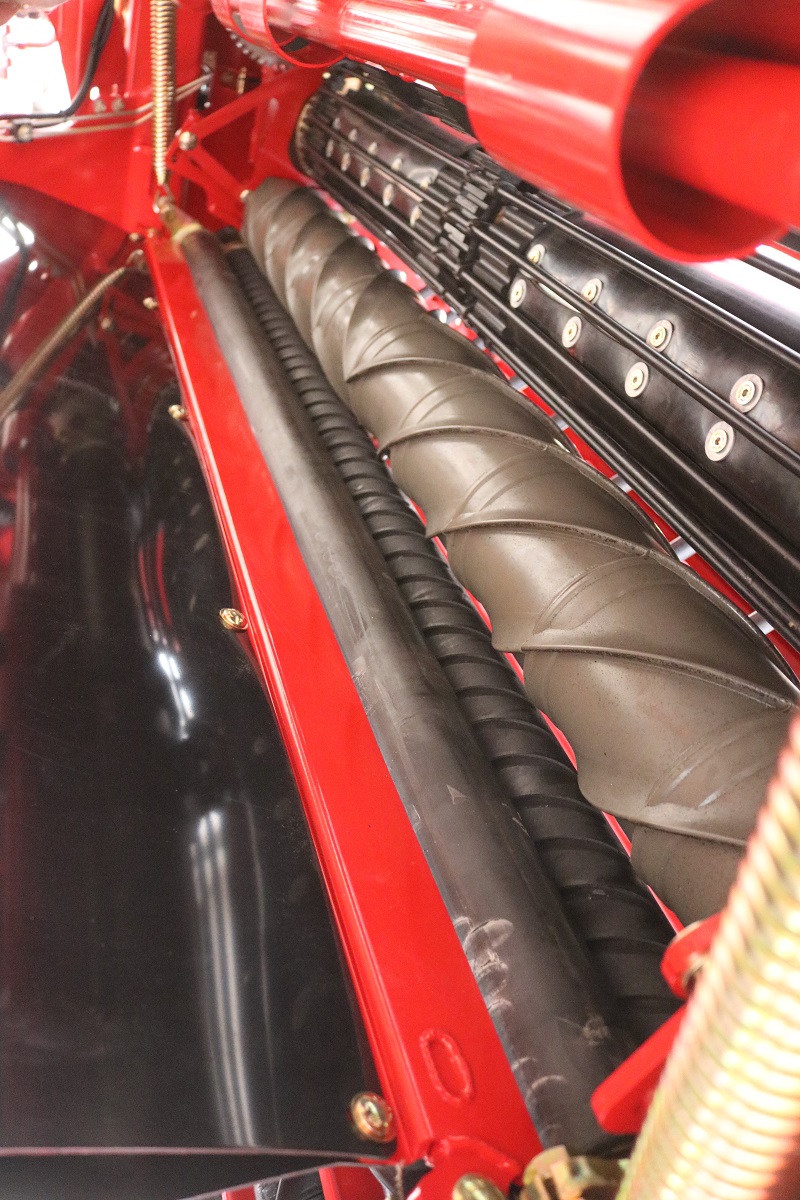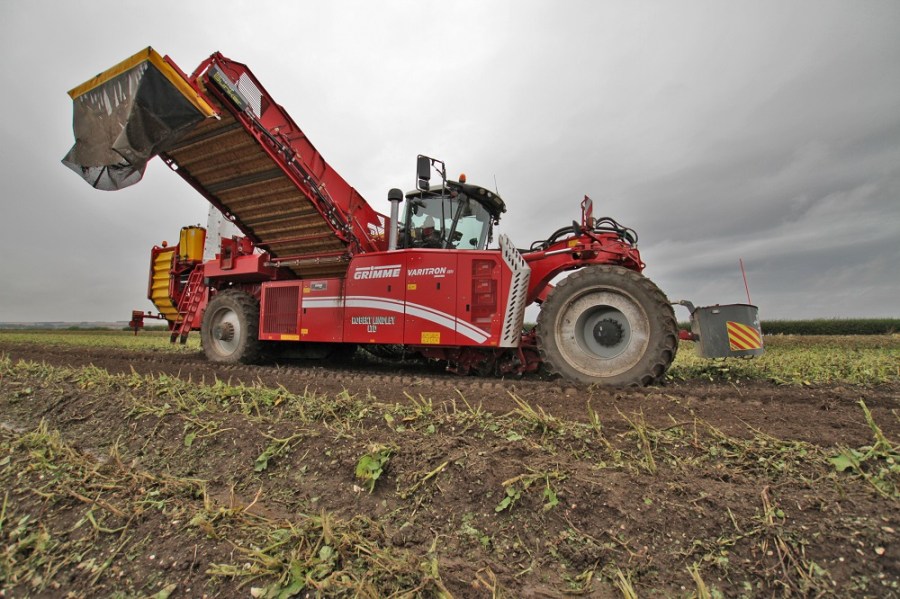Grimme has earned a number of industry awards for developments to its potato-harvesting technology. CPM peers inside the machines for an insight into what they do.
I don’t think there’s anything we can’t achieve, once we set our mind to it.
By Tom Allen-Stevens
Among the brand new and older Varitron self-propelled potato harvesters you’ll find at Grimme UK’s headquarters at Swineshead, Lincs, are a few in the workshop that have spilled their sides for a repair or modification that’s in progress.
But you get the impression the technicians aren’t so much servicing a machine as tending to a valued member of the team – there’s a palpable pride in the technology that’s disassembled on the concrete floor, summed up by Adam Johnson from the Grimme UK marketing team as he searches around for a cut-away cylinder that illustrates the firm’s Terra-Control.

It’s not until you take a Grimme harvester apart that you appreciate just how much the technology has evolved, says Adam Johnson.
“There’s some really clever thinking that’s gone into these machines,” he says. “It’s largely taken for granted, but it’s not until you take one apart that you appreciate just how much our harvesting technology has evolved.”
He joined the firm six years ago as an engineer at the firm’s York depot, and confesses he’s an enthusiast for the innovations on the potato harvester range, and for those he’s seen develop since. “Terra-Control, for example, remains one of the most advanced systems on the market – it’s not just about autodepth,” he says.

The segmented roller, followed by a fluted roller, creates a ‘back-and-forth’ movement that helps remove the haulm.
Terra-Control earned Grimme a DLG silver medal when it was unveiled at Agritechnica in 2005. The system uses special hydraulic cylinders, guided by the diablo as it runs over the ridge, to set the depth of the share (see panel on pxx).
“The really clever bit is the strip of sensor tape inside the ram that monitors the diablo position as it moves up and down and passes this information through to the control panel,” notes Adam Johnson.
Within Terra-Control there are three functions – depth control, ridge pressure and depth sensitivity. The system allows the operator to adjust the depth control according to field conditions. So if working on sandy conditions, for example, additional pressure can be added to the potato ridge to improve flow without effecting digging depth.
More recently, Delta control has been introduced to the system. “While the diablos move independently, they set the height of the shares on a plane. But sometimes, due to a damaged ridge or spray wheelings, you want to adjust one side individually to prevent excessive digging – Delta control allows you to do that,” he explains.
A lot of the developments start with the operator, continues Adam Johnson. “If a customer has a problem, we’ll always get to the bottom of it. If it can’t be addressed through adjustments or settings on the machine, that’s when we bring in the design team from Germany who look into it.”
If there’s a design change that solves the issue, this will be put in place – sometimes carried out on an individual machine, and occasionally over an entire range. Otherwise the team works on developing a solution, that may be rolled out on a future model.
“I don’t think there’s anything we can’t achieve, once we set our mind to it,” says Adam Johnson. “The haulm extraction is a good example.”
The technology that’s been developed in the Multisep has been introduced into the haulm-extraction element that follows the first main web. “We used to have a solid haulm roller directly against the web, but it was too aggressive and have high wear rates in stoney soils. So we put a segmented roller – similar to those found in the Multisep, but a bit harder – between the web and the haulm roller.”
The single segmented roller, followed by a fluted roller, creates a ‘back-and-forth’ movement that helps remove the haulm, he claims. “As a result, you now get the best of both worlds – haulm is extracted from the passing crop flow but due to the collapsible segments, only the area opens, unlike the traditional haulm roller where the full roller would move away from the main web. This gives excellent haulm separation whilst being very gentle with the crop.”
Monitoring what’s going on at this point is crucial, he reckons. “That’s why Grimme introduced cameras to cover key areas of the machine. We’ve now taken that one step further with Visual Protect.”
This is another innovation that won Grimme a DLG silver medal in 2007. “The cameras are all very well – six come as standard and you can have up to eight. But we found operators generally had them trained on just two areas – the main web and on the separator, flicking to the cart elevator when unloading.”
So Visual Protect overrides which view the operator sees if a problem is detected anywhere on the machine, explains Adam Johnson. “If the Multi-sep begins to back up while the operator is focused on unloading, for example, the monitor will switch automatically to show that view and the terminal beeps so the operator can take the appropriate action.”
But problems associated with uneven crop flow have been minimised thanks to Driving Speed Control, he continues. “The main webs are driven by hydraulic motors, maintaining a constant speed, irrespective of forward speed. But if the crop intake becomes lighter, the operator may want to step up the forward speed.”
On Grimme harvesters, the speed of the main intake web is matched to the forward speed, allowing for a more constant speed of crop throughput. “This also means the intake slows down if the harvester comes across a thick patch and the operator drops the forward speed – it’s one less thing to worry about.”
An option on the Varitron 270 is Autopilot. This is an autosteer function, guided by two fingers that drop down at the front either side of the row. “GPS-guided autosteer doesn’t really work because the row may not be exactly straight,” points out Adam Johnson.
Advances have also come towards the rear of the machine. “Self-propelled harvesters have a ring elevator at the rear to handle the harvested crop. It’s made of a durable material, but if it’s damaged, it can be a lengthy job to repair.”
Optibag was developed, initially as a more hard-wearing solution. The crop is held in a mesh, rather than a solid sheet, which enables further soil separation. “The really clever bit is how it’s put together,” he says. “The pockets are made up of individual sheets that are clipped to the frame – to replace one is a ten-minute job and the web is half the weight of a standard unit.”
Although an option, few harvesters are now specced without Optibag, he says. “When it was first introduced in 2011, many growers viewed it with scepticism. There was a test machine that went up to a Yorks grower with flinty soil, for example. He didn’t think it would solve the problems he’d had with damage to the ring elevator and said I’d be taking the new machine off him before the end of the season. But when I got in touch later that harvest, he’d completely changed his view – he said he couldn’t believe how well it worked.”
The willingness by growers to try new developments has helped bring them on, he adds. “I think growers buy Grimme because they trust us. They’ll see a change, and they may be sceptical about it at first, but they’re prepared to give it a whirl because they trust us to deliver on what we promise.”
In a number of areas, the company works closely with the industry to develop solutions to ongoing issues. Bruising is a good example, notes Adam Johnson. “It’s a particularly acute problem for UK growers, and has been the subject of AHDB-funded research. We’ve always aimed to be involved in those projects so we can be at the forefront of developments.”
This contributed to the development of Speedtronic on trailed harvesters, that gained Grimme a DLG silver medal in 2011. “When the crop hits the elevator, that’s a direction change, which has been found to be a key damage area. With Speedtronic, two sensors monitor how full the pockets are, and you can adjust that from the cab. The speed of the elevator is then automatically set to ensure optimum fill of the pockets, which reduces bruising,” he explains.
Such industry involvement is just part of the £10M the company spends on R&D every year, he notes. Design tweaks are rigorously tested and scientifically evaluated in field trails before they’re rolled out commercially.
“One development I think growers will really like is Ergodrive, that’s due to be launched at Grimme Technica next month,” notes Adam Johnson. “It’s among changes to the new Varitron Platinum range that was unveiled two months ago.”
Alongside a new Tier 4-compliant engine is a new control system and command arm that’s been adapted from Grimme’s sugar beet harvester. “While before you had to sift through screens on the control panel to get to the setting you want, you can now put them close at hand, and programme the command arm so they’re at your fingertips. It’s a lot more user friendly – functions like Cleancontrol are available at the flick of a switch.”
The new Varitron Platinum range will be on show for the first time in the UK at LAMMA in Jan 2017, says Adam Johnson, and he reckons it’ll draw some attention. “We know we make a premium product at a premium price, but growers know they get cutting-edge technology from that investment and unrivalled back-up and support. We not only introduce innovations, we’ll stand by them, whatever, and it’s that reassurance that allows growers to get the best performance in the field,” he says.
How Terra-Control sets the depth
The swing frame (1) is held in position by two cylinders (2). When Terra-Control is used, the diablo rollers (3) are supported on two hydraulic cylinders that have an integrated path-measuring system (4).
These hydraulic cylinders register every deviation of the ridge crest height and transfer the signal electrohydraulically to the two swing frame cylinders. This means the digging depth and diablo pressure remain constant at all times, and with every soil contour.
TRACKED SELF PROPELLED HARVESTER ASSET IN WET CONDITIONS
Claiming a potato harvester ‘can walk on water’ may be bordering on exaggeration when describing the way a self-propelled Grimme Varitron 270 keeps going in soft ground conditions. But, Gary Adamson, operations’ manager for Fridlington Farms, based in the Vale of York is clearly impressed with his.
“We grow 120ha on the home farm and rent ground from other farmers in the district to make up the 250hs acres,” he explains. “Grown on contract to McCain Foods and Walker Crisps, the varieties are main crop and include those such as Lady Rosetta, Hermes and Royal.”
The decision to invest in a self-propelled potato harvester was made because of previous experience of harvesting in the wet with two-row trailed machines that needed trailers to run alongside them, which made the going very difficult, he says.
“The Varitron 270 is a two-row machine powered by a 280hp Mercedes Benz engine. Diablo rollers are used to lift the crop onto the hydraulically driven first main web and this has a speed-adjustable rocker agitator. The second web takes the crop to the double MultiSep unit which then delivers the potatoes to the large picking off table.”
The potatoes are then conveyed to a flat floored bunker having a capacity of 7000kg and, for unloading, a three-section web conveyor.
“I like the reversible unloading web on this machine that allows the outgoing crop to be returned to the bunker when the trailer or boxes have been filled,” he says. “This then means the delivery end of the bunker-loading conveyor from the picking table can return to a position just above the potatoes which reduces the drop height and the risk of bruising.”
The usual unloading routine is for the trailers loaded with boxes to line up in a row and for the harvester to move along filling the boxes as it does so. In difficult conditions the trailers remain on the headlands and the harvester runs to them.
The running gear on the Varitron is one of the main reasons behind Gary Adamson’s decision to purchase the machine. There’s a single front hydrostatically driven wheel with demand traction control and then, on the rear right, is a second wheel, while on the left a rubber track 900mm wide and 2970mm long. For steering, the front wheel can turn to an angle of 70° and the rear to +/-13°, which results in an inner turning radius of only 2.5m.
“The weight loading is just so good,” he enthuses. “Not only does it ensure the harvester keeps moving in marginal conditions, it also reduces the damage to the soil so that following crops don’t suffer from the aftermath of harvesting.”
For the operator, there’s a degree of comfort now considered to be essential for such high profile machines. “The best feature of the cab is the tremendous vision it provides of the intake unit and the first web, and the fact that it really is a comfortable place to be.”
Innovation Insight
CPM would like to thank Grimme UK for kindly sponsoring this article, and for providing privileged access to staff and material used to help put the article together![]()




